Abstract
The purpose of this review article is to demonstrate the close parallelism of daily requirements, biological activity and minimum and maximum tolerable levels of selenium for animals and man. In addition, the carcinogenic/anticarcinogenic properties of selenium are discussed and a postulate of how these dichotomous effects may occur in accordance with selenium-induced immunomodulation is presented. A review of pertinent literature pertaining to the biological action of selenium in animals and man, including deficiency, toxicity, carcinogenicity and effects on immunity, is included to support these concepts. The predominant biochemical action of selenium in both animals and man is to serve as an antioxidant via the selenium-dependent enzyme, glutathione peroxidase, and thus protect cellular membranes and organelles from peroxidative damage. The signs and symptoms of selenium deficiency closely simulate each other for animals and man. Severe deficiency is characterized by cardiomyopathy while moderate deficiency results in less severe, myodegenerative syndromes such as muscular weakness and pain as well as a variety of other selenium-associated diseases. Clinical manifestations of many of these disorders require contributory factors, such as stress, to precipitate symptoms which are documented for animals and implicated for humans. Current evidence suggests that a daily selenium consumption for man of approximately 30 micrograms is necessary to prevent the selenium-deficient syndrome, Keshan disease, while approximately 90 micrograms/day/adult should be the minimum daily requirement for optimum biological performance. Recognizing that humans in several countries do not meet the proposed minimum daily requirement of 90 micrograms, several compelling reasons are presented in deriving this minimal daily nutritional intake. Selenosis can occur in laboratory animals, livestock, and humans following long-term exposure to selenium concentrations as low as 5 mg selenium/kg of diet (5 ppm). The selenium-induced lesions for all species are similar, which once again illustrates a positive corollary for selenium effects in both animals and man. From compilation of available data, the maximum tolerable level for selenium in man could be considered in the range of 1000 to 1500 micrograms/day. This is in contrast to the currently recommended maximum human tolerable level of 500 micrograms/day. The amount of selenium that can be tolerated, however, is dependent upon individual biological variation, nutritional status and general state of health.(ABSTRACT TRUNCATED AT 400 WORDS)
Full text
PDF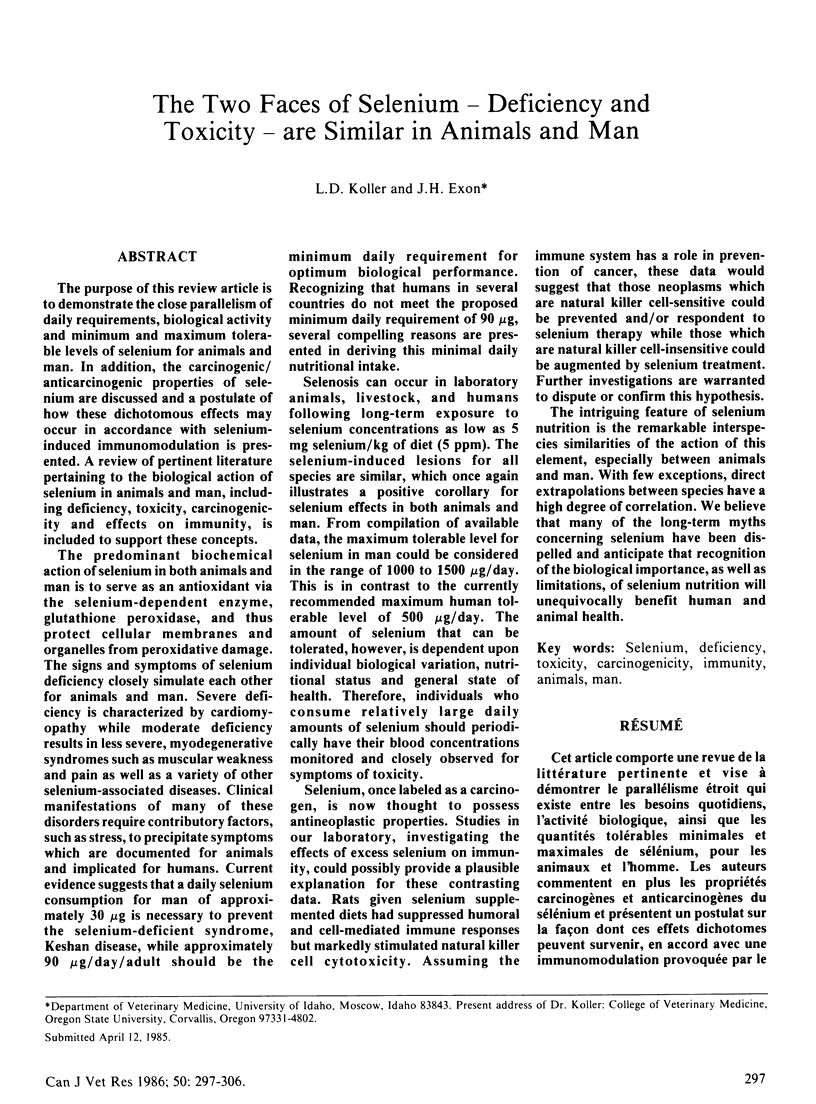
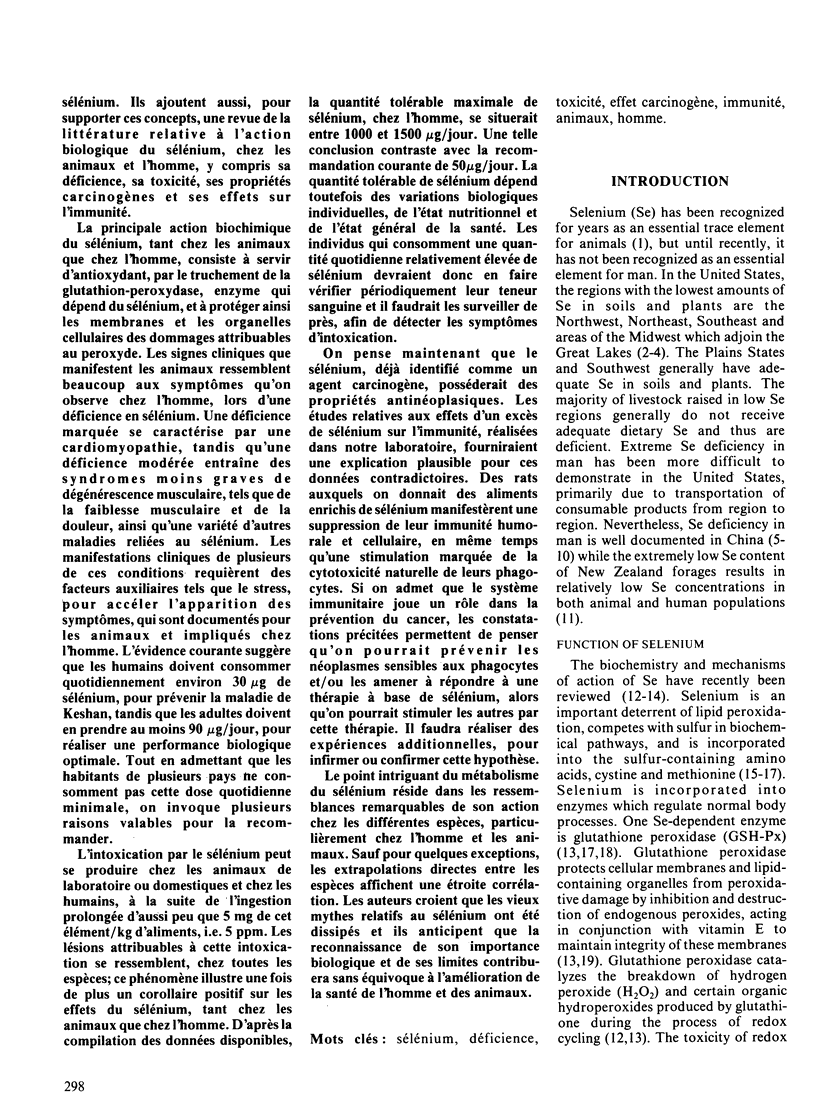
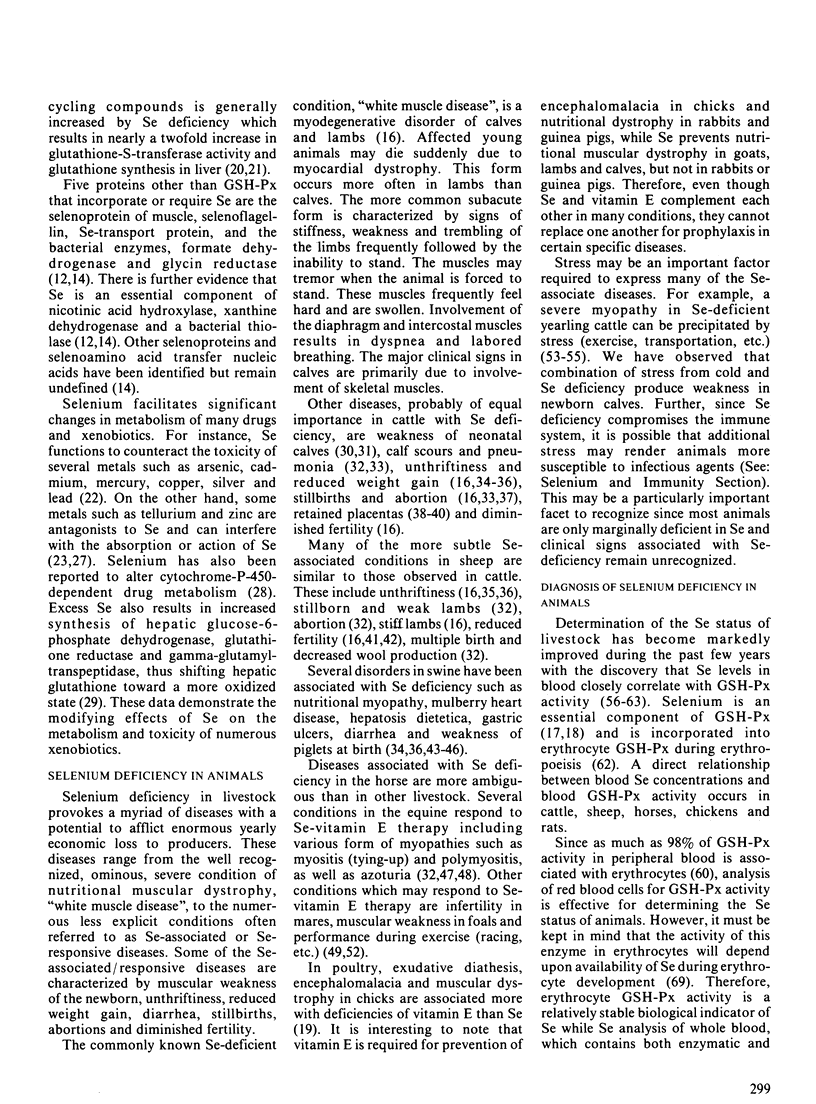
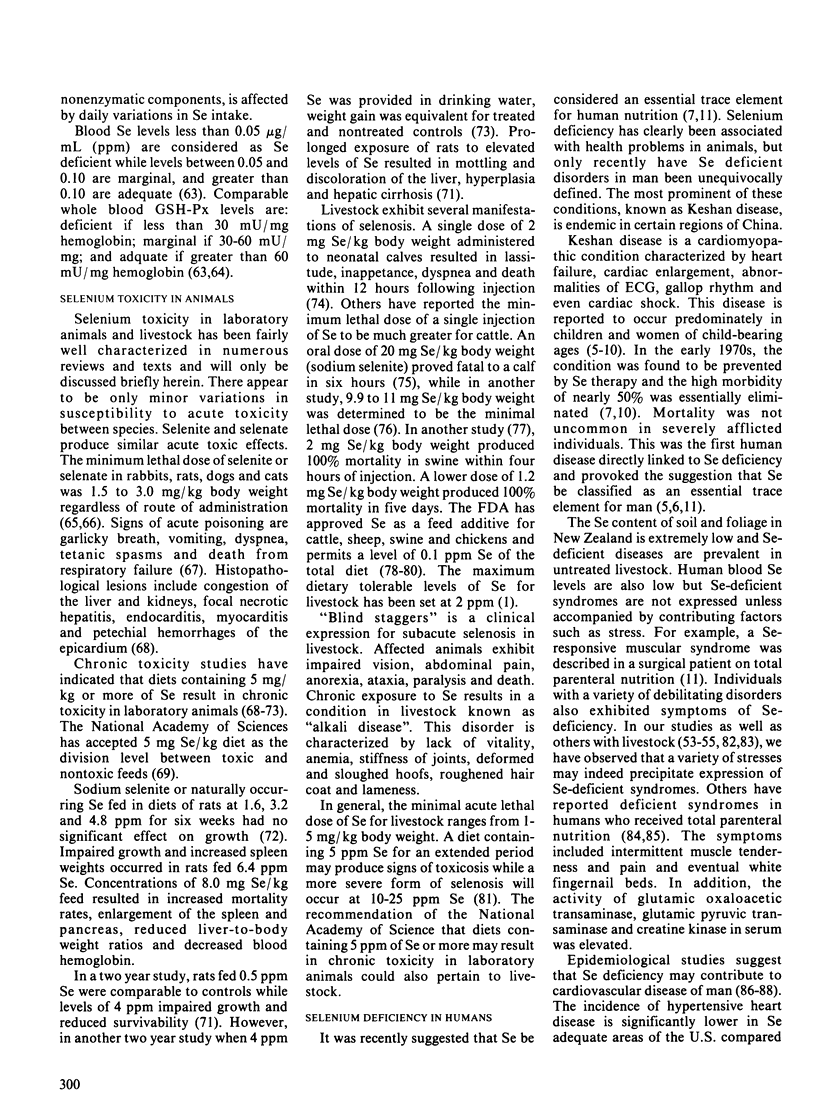
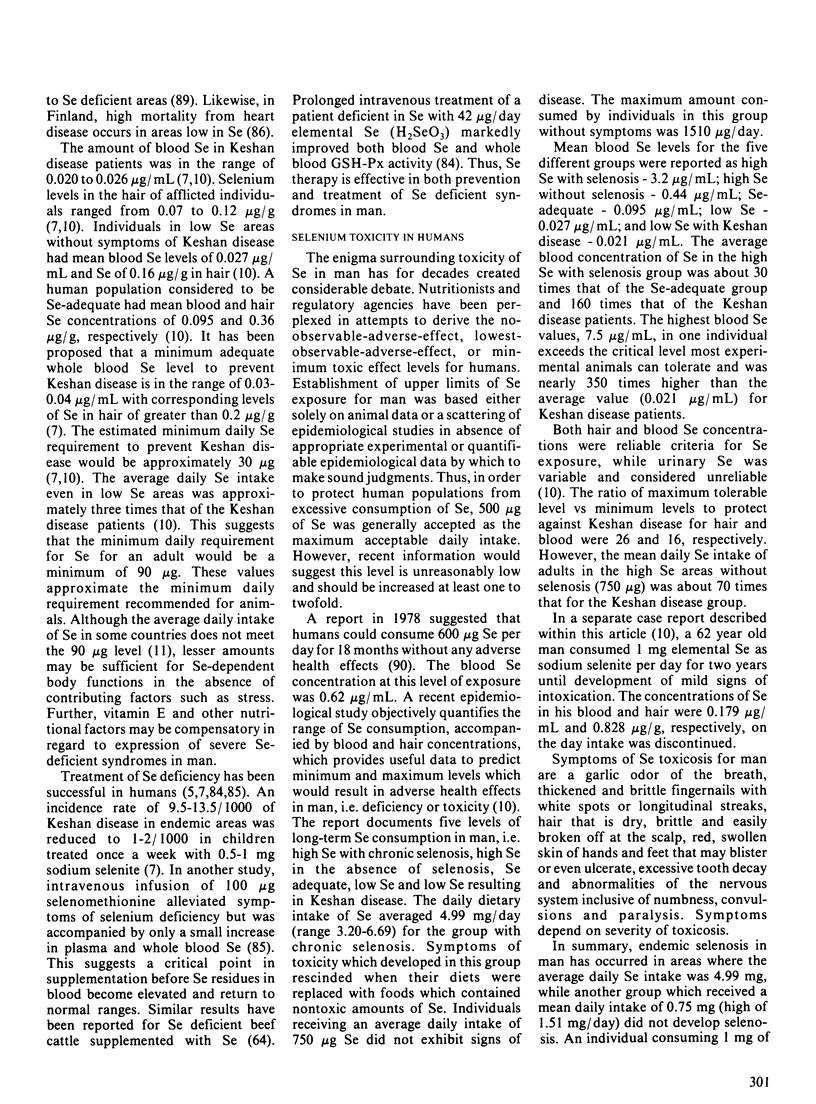
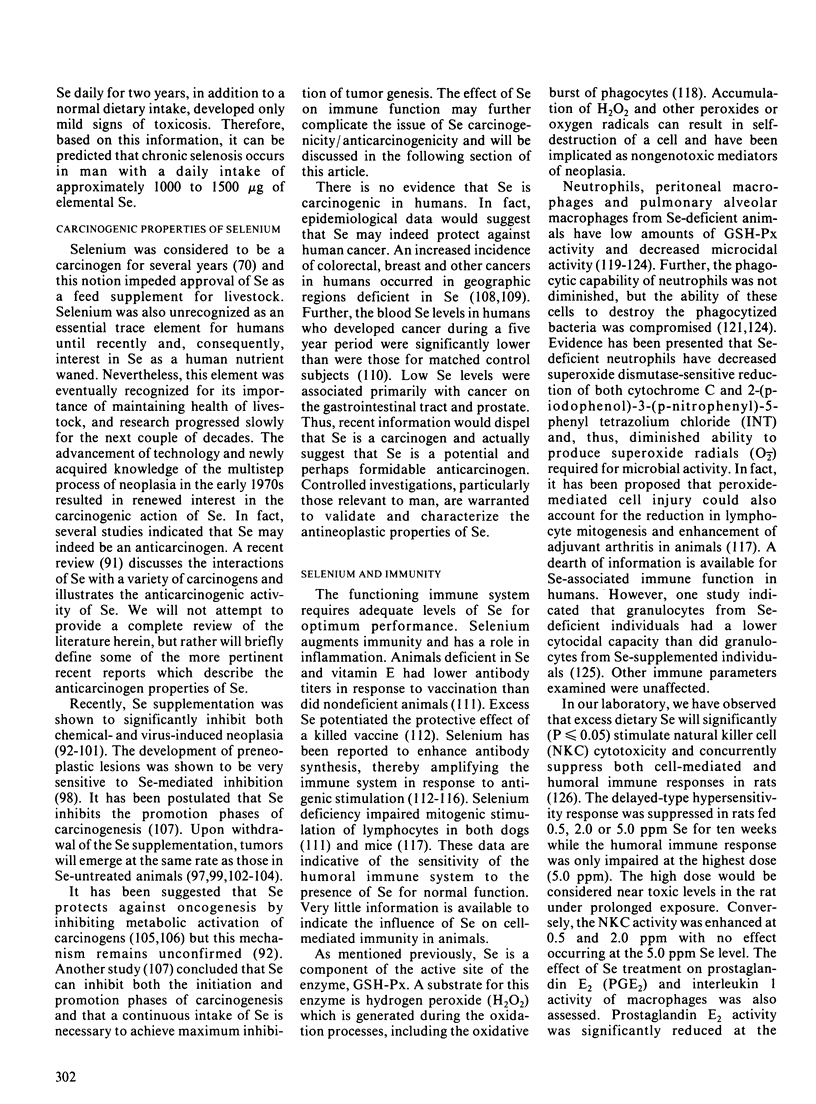
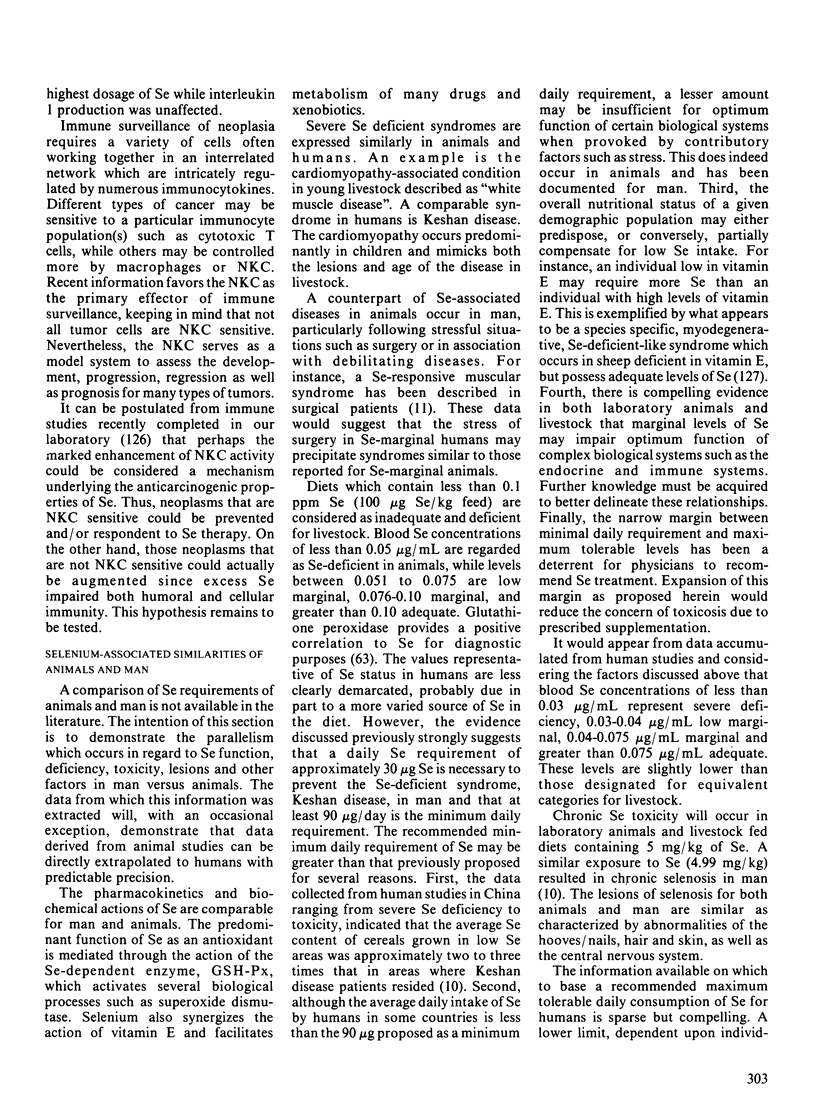
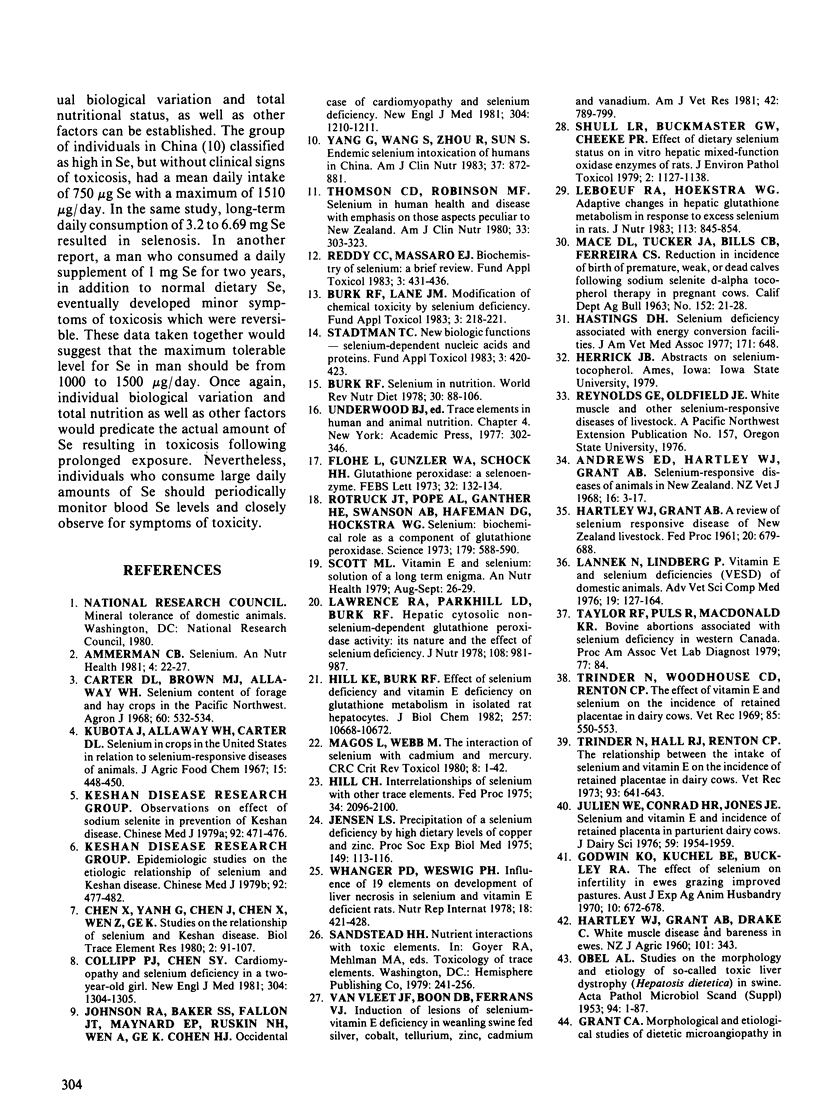
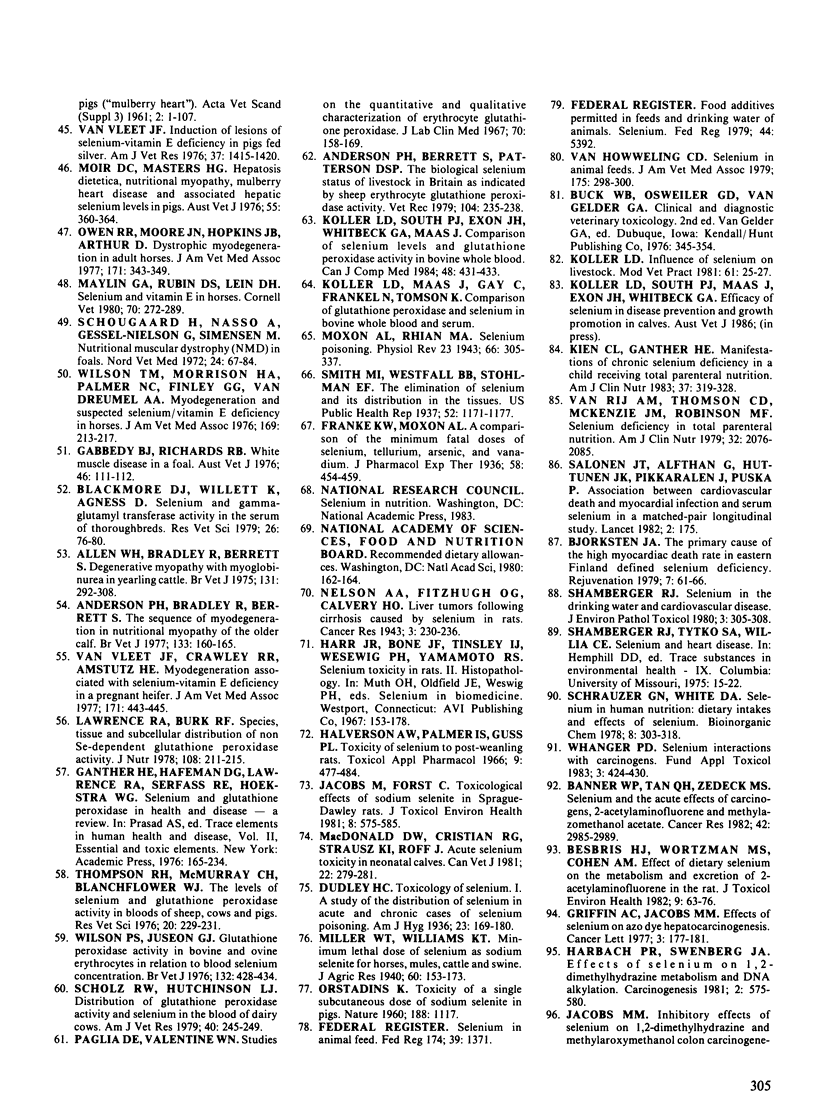
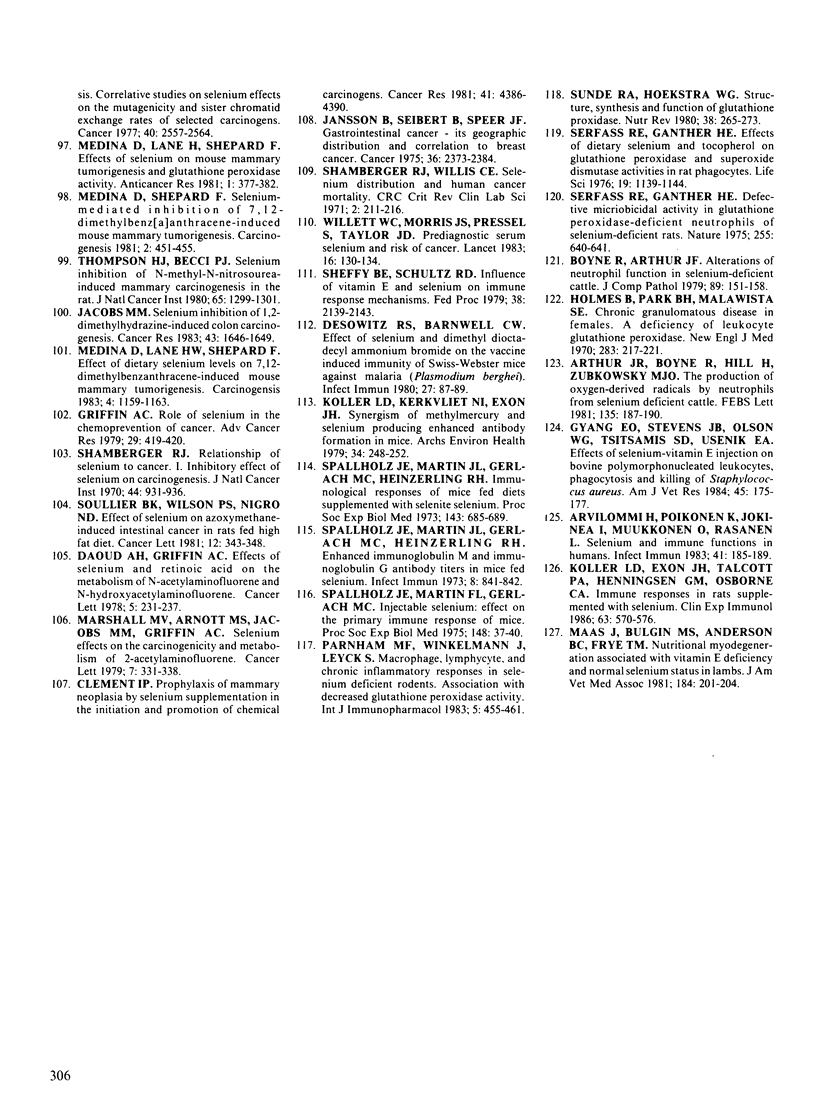
Selected References
These references are in PubMed. This may not be the complete list of references from this article.
- Allen W. M., Bradley R., Berrett S., Parr W. H., Swannack K., Barton C. R., Macphee A. Degenerative myopathy with myoglobinuria in yearling cattle. Br Vet J. 1975 May-Jun;131(3):292–308. doi: 10.1016/s0007-1935(17)35286-7. [DOI] [PubMed] [Google Scholar]
- Anderson P. H., Berrett S., Patterson D. S. The biological selenium status of livestock in Britain as indicated by sheep erythrocyte glutathione peroxidase activity. Vet Rec. 1979 Mar 17;104(11):235–238. doi: 10.1136/vr.104.11.235. [DOI] [PubMed] [Google Scholar]
- Anderson P. H., Bradley R., Berrett S., Patterson D. S. The sequence of myodegeneration in nutritional myopathy of the older calf. Br Vet J. 1977 Mar-Apr;133(2):160–165. doi: 10.1016/s0007-1935(17)34137-4. [DOI] [PubMed] [Google Scholar]
- Andrews E. D., Hartley W. J., Grant A. B. Selenium-responsive diseases of animals in New Zealand. N Z Vet J. 1968 Jan-Feb;16(1-2):3–17. doi: 10.1080/00480169.1968.33738. [DOI] [PubMed] [Google Scholar]
- Arthur J. R., Boyne R., Hill H. A., Okolow-Zubkowska M. J. The production of oxygen-derived radicals by neutrophils from selenium-deficient cattle. FEBS Lett. 1981 Nov 30;135(1):187–190. doi: 10.1016/0014-5793(81)80973-8. [DOI] [PubMed] [Google Scholar]
- Arvilommi H., Poikonen K., Jokinen I., Muukkonen O., Räsänen L., Foreman J., Huttunen J. K. Selenium and immune functions in humans. Infect Immun. 1983 Jul;41(1):185–189. doi: 10.1128/iai.41.1.185-189.1983. [DOI] [PMC free article] [PubMed] [Google Scholar]
- Banner W. P., Tan Q. H., Zedeck M. S. Selenium and the acute effects of the carcinogens, 2-acetylaminofluorene and methylazoxymethanol acetate. Cancer Res. 1982 Aug;42(8):2985–2989. [PubMed] [Google Scholar]
- Besbris H. J., Wortzman M. S., Cohen A. M. Effect of dietary selenium on the metabolism and excretion of 2-acetylaminofluorene in the rat. J Toxicol Environ Health. 1982 Jan;9(1):63–76. doi: 10.1080/15287398209530142. [DOI] [PubMed] [Google Scholar]
- Blackmore D. J., Willett K., Agness D. Selenium and gamma-glutamyl transferase activity in the serum of thoroughbreds. Res Vet Sci. 1979 Jan;26(1):76–80. [PubMed] [Google Scholar]
- Boyne R., Arthur J. R. Alterations of neutrophil function in selenium-deficient cattle. J Comp Pathol. 1979 Jan;89(1):151–158. doi: 10.1016/0021-9975(79)90018-5. [DOI] [PubMed] [Google Scholar]
- Burk R. F., Lane J. M. Modification of chemical toxicity by selenium deficiency. Fundam Appl Toxicol. 1983 Jul-Aug;3(4):218–221. doi: 10.1016/s0272-0590(83)80129-8. [DOI] [PubMed] [Google Scholar]
- Burk R. F. Selenium in nutrition. World Rev Nutr Diet. 1978;30:88–106. doi: 10.1159/000401237. [DOI] [PubMed] [Google Scholar]
- Collipp P. J., Chen S. Y. Cardiomyopathy and selenium deficiency in a two-year-old girl. N Engl J Med. 1981 May 21;304(21):1304–1305. doi: 10.1056/NEJM198105213042120. [DOI] [PubMed] [Google Scholar]
- Daoud A. H., Griffin A. C. Effects of selenium and retinoic acid on the metabolism of N-acetylaminofluorene and N-hydroxyacetylamino-fluorene. Cancer Lett. 1978 Oct;5(4):231–237. doi: 10.1016/s0304-3835(78)80045-7. [DOI] [PubMed] [Google Scholar]
- Desowitz R. S., Barnwell J. W. Effect of selenium and dimethyl dioctadecyl ammonium bromide on the vaccine-induced immunity of Swiss-Webster mice against malaria (Plasmodium berghei). Infect Immun. 1980 Jan;27(1):87–89. doi: 10.1128/iai.27.1.87-89.1980. [DOI] [PMC free article] [PubMed] [Google Scholar]
- Flohe L., Günzler W. A., Schock H. H. Glutathione peroxidase: a selenoenzyme. FEBS Lett. 1973 May 15;32(1):132–134. doi: 10.1016/0014-5793(73)80755-0. [DOI] [PubMed] [Google Scholar]
- Gabbedy B. J., Richards R. B. White muscle disease in a foal. Aust Vet J. 1970 Mar;46(3):111–112. doi: 10.1111/j.1751-0813.1970.tb15934.x. [DOI] [PubMed] [Google Scholar]
- Griffin A. C., Jacobs M. M. Effects of selenium on azo dye hepatocarcinogenesis. Cancer Lett. 1977 Sep;3(3-4):177–181. doi: 10.1016/s0304-3835(77)95431-3. [DOI] [PubMed] [Google Scholar]
- Griffin A. C. Role of selenium in the chemoprevention of cancer. Adv Cancer Res. 1979;29:419–442. doi: 10.1016/s0065-230x(08)60851-9. [DOI] [PubMed] [Google Scholar]
- Gyang E. O., Stevens J. B., Olson W. G., Tsitsamis S. D., Usenik E. A. Effects of selenium-vitamin E injection on bovine polymorphonucleated leukocytes phagocytosis and killing of Staphylococcus aureus. Am J Vet Res. 1984 Jan;45(1):175–177. [PubMed] [Google Scholar]
- HARTLEY W. J., GRANT A. B. A review of selenium responsive diseases of New Zealand livestock. Fed Proc. 1961 Jul;20:679–688. [PubMed] [Google Scholar]
- Harbach P. R., Swenberg J. A. Effects of selenium on 1,2-dimethylhydrazine metabolism and DNA alkylation. Carcinogenesis. 1981;2(7):575–580. doi: 10.1093/carcin/2.7.575. [DOI] [PubMed] [Google Scholar]
- Hill C. H. Interrelationships of selenium with other trace elements. Fed Proc. 1975 Oct;34(11):2096–2100. [PubMed] [Google Scholar]
- Hill K. E., Burk R. F. Effect of selenium deficiency and vitamin E deficiency on glutathione metabolism in isolated rat hepatocytes. J Biol Chem. 1982 Sep 25;257(18):10668–10672. [PubMed] [Google Scholar]
- Holmes B., Park B. H., Malawista S. E., Quie P. G., Nelson D. L., Good R. A. Chronic granulomatous disease in females. N Engl J Med. 1970 Jul 30;283(5):217–221. doi: 10.1056/NEJM197007302830501. [DOI] [PubMed] [Google Scholar]
- Ip C. Prophylaxis of mammary neoplasia by selenium supplementation in the initiation and promotion phases of chemical carcinogenesis. Cancer Res. 1981 Nov;41(11 Pt 1):4386–4390. [PubMed] [Google Scholar]
- Jacobs M. M. Inhibitory effects of selenium on 1,2-dimethylhydrazine and methylazoxymethanol colon carcinogenesis: correlative studies on selenium effects on the mutagenicity and sister chromatid exchange rates of selected carcinogens. Cancer. 1977 Nov;40(5 Suppl):2557–2564. doi: 10.1002/1097-0142(197711)40:5+<2557::aid-cncr2820400925>3.0.co;2-t. [DOI] [PubMed] [Google Scholar]
- Jacobs M. M. Selenium inhibition of 1,2-dimethylhydrazine-induced colon carcinogenesis. Cancer Res. 1983 Apr;43(4):1646–1649. [PubMed] [Google Scholar]
- Jacobs M., Forst C. Toxicological effects of sodium selenite in Sprague-Dawley rats. J Toxicol Environ Health. 1981 Oct;8(4):575–585. doi: 10.1080/15287398109530092. [DOI] [PubMed] [Google Scholar]
- Jansson B., Seibert B., Speer J. F. Gastrointestinal cancer. Its geographic distribution and correlation to breast cancer. Cancer. 1975 Dec;36(6 Suppl):2373–2384. doi: 10.1002/1097-0142(197512)36:6<2373::aid-cncr2820360616>3.0.co;2-n. [DOI] [PubMed] [Google Scholar]
- Jensen L. S. Precipitation of a selenium deficiency by high dietary levels of copper and zinc. Proc Soc Exp Biol Med. 1975 May;149(1):113–116. doi: 10.3181/00379727-149-38754. [DOI] [PubMed] [Google Scholar]
- Johnson R. A., Baker S. S., Fallon J. T., Maynard E. P., 3rd, Ruskin J. N., Wen Z., Ge K., Cohen H. J. An occidental case of cardiomyopathy and selenium deficiency. N Engl J Med. 1981 May 14;304(20):1210–1212. doi: 10.1056/NEJM198105143042005. [DOI] [PubMed] [Google Scholar]
- Julien W. E., Conrad H. R., Jones J. E., Moxon A. L. Selenium and vitamin E and incidence of retained placenta in parturient dairy cows. J Dairy Sci. 1976 Nov;59(11):1954–1959. doi: 10.3168/jds.S0022-0302(76)84467-0. [DOI] [PubMed] [Google Scholar]
- Kien C. L., Ganther H. E. Manifestations of chronic selenium deficiency in a child receiving total parenteral nutrition. Am J Clin Nutr. 1983 Feb;37(2):319–328. doi: 10.1093/ajcn/37.2.319. [DOI] [PubMed] [Google Scholar]
- Koller L. D., Exon J. H., Talcott P. A., Osborne C. A., Henningsen G. M. Immune responses in rats supplemented with selenium. Clin Exp Immunol. 1986 Mar;63(3):570–576. [PMC free article] [PubMed] [Google Scholar]
- Koller L. D. Influence of selenium on livestock. Mod Vet Pract. 1981 Jan;62(1):25–27. [PubMed] [Google Scholar]
- Koller L. D., Isaacson-Kerkvliet N., Exon J. H., Brauner J. A., Patton N. M. Synergism of methylmercury and selenium producing enhanced antibody formation in mice. Arch Environ Health. 1979 Jul-Aug;34(4):248–252. doi: 10.1080/00039896.1979.10667408. [DOI] [PubMed] [Google Scholar]
- Koller L. D., South P. J., Exon J. H., Whitbeck G. A., Maas J. Comparison of selenium levels and glutathione peroxidase activity in bovine whole blood. Can J Comp Med. 1984 Oct;48(4):431–433. [PMC free article] [PubMed] [Google Scholar]
- Lannek N., Lindberg P. Vitamin E and selenium deficiencies (VESD) of domestic animals. Adv Vet Sci Comp Med. 1975;19:127–164. [PubMed] [Google Scholar]
- Lawrence R. A., Burk R. F. Species, tissue and subcellular distribution of non Se-dependent glutathione peroxidase activity. J Nutr. 1978 Feb;108(2):211–215. doi: 10.1093/jn/108.2.211. [DOI] [PubMed] [Google Scholar]
- Lawrence R. A., Parkhill L. K., Burk R. F. Hepatic cytosolic non selenium-dependent glutathione peroxidase activity: its nature and the effect of selenium deficiency. J Nutr. 1978 Jun;108(6):981–987. doi: 10.1093/jn/108.6.981. [DOI] [PubMed] [Google Scholar]
- LeBoeuf R. A., Hoekstra W. G. Adaptive changes in hepatic glutathione metabolism in response to excess selenium in rats. J Nutr. 1983 Apr;113(4):845–854. doi: 10.1093/jn/113.4.845. [DOI] [PubMed] [Google Scholar]
- Maas J., Bulgin M. S., Anderson B. C., Frye T. M. Nutritional myodegeneration associated with vitamin E deficiency and normal selenium status in lambs. J Am Vet Med Assoc. 1984 Jan 15;184(2):201–204. [PubMed] [Google Scholar]
- MacDonald D. W., Christian R. G., Strausz K. I., Roff J. Acute selenium toxicity in neonatal calves. Can Vet J. 1981 Sep;22(9):279–281. [PMC free article] [PubMed] [Google Scholar]
- Magos L., Webb M. The interactions of selenium with cadmium and mercury. Crit Rev Toxicol. 1980 Nov;8(1):1–42. doi: 10.3109/10408448009037490. [DOI] [PubMed] [Google Scholar]
- Marshall M. V., Arnott M. S., Jacobs M. M., Griffin A. C. Selenium effects on the carcinogenicity and metabolism of 2-acetylaminofluorene. Cancer Lett. 1979 Oct;7(6):331–338. doi: 10.1016/s0304-3835(79)80062-2. [DOI] [PubMed] [Google Scholar]
- Maylin G. A., Rubin D. S., Lein D. H. Selenium and vitamin E in horses. Cornell Vet. 1980 Jul;70(3):272–289. [PubMed] [Google Scholar]
- McMurray C. H., Blanchflower W. J. The levels of selenium and glutathione peroxidase activity in blood of sheep, cows and pigs. Res Vet Sci. 1976 Mar;20(2):229–231. [PubMed] [Google Scholar]
- Medina D., Lane H. W., Shepherd F. Effect of dietary selenium levels on 7,12-dimethylbenzanthracene-induced mouse mammary tumorigenesis. Carcinogenesis. 1983 Sep;4(9):1159–1163. doi: 10.1093/carcin/4.9.1159. [DOI] [PubMed] [Google Scholar]
- Medina D., Lane H., Shepherd F. Effects of selenium on mouse mammary tumorigenesis and glutathione peroxidase activity. Anticancer Res. 1981;1(6):377–382. [PubMed] [Google Scholar]
- Medina D., Shepherd F. Selenium-mediated inhibition of 7,12-dimethylbenz[a]anthracene-induced mouse mammary tumorigenesis. Carcinogenesis. 1981;2(5):451–455. doi: 10.1093/carcin/2.5.451. [DOI] [PubMed] [Google Scholar]
- Moir D. C., Masters H. G. Hepatosis dietetica, nutritional myopathy, mulberry heart disease and associated hepatic selenium level in pigs. Aust Vet J. 1979 Aug;55(8):360–364. doi: 10.1111/j.1751-0813.1979.tb15889.x. [DOI] [PubMed] [Google Scholar]
- OBEL A. L. Studies on the morphology and etiology of so-called toxic liver dystrophy (hepatosis diaetetica) in swine. Acta Pathol Microbiol Scand Suppl. 1953;94:1–119. [PubMed] [Google Scholar]
- Owen R. R., Moore J. N., Hopkins J. B., Arthur D. Dystrophic myodegeneration in adult horses. J Am Vet Med Assoc. 1977 Aug 15;171(4):343–349. [PubMed] [Google Scholar]
- Paglia D. E., Valentine W. N. Studies on the quantitative and qualitative characterization of erythrocyte glutathione peroxidase. J Lab Clin Med. 1967 Jul;70(1):158–169. [PubMed] [Google Scholar]
- Parnham M. J., Winkelmann J., Leyck S. Macrophage, lymphocyte and chronic inflammatory responses in selenium deficient rodents. Association with decreased glutathione peroxidase activity. Int J Immunopharmacol. 1983;5(5):455–461. doi: 10.1016/0192-0561(83)90022-x. [DOI] [PubMed] [Google Scholar]
- Reddy C. C., Massaro E. J. Biochemistry of selenium: a brief overview. Fundam Appl Toxicol. 1983 Sep-Oct;3(5):431–436. doi: 10.1016/s0272-0590(83)80017-7. [DOI] [PubMed] [Google Scholar]
- Rotruck J. T., Pope A. L., Ganther H. E., Swanson A. B., Hafeman D. G., Hoekstra W. G. Selenium: biochemical role as a component of glutathione peroxidase. Science. 1973 Feb 9;179(4073):588–590. doi: 10.1126/science.179.4073.588. [DOI] [PubMed] [Google Scholar]
- Salonen J. T., Alfthan G., Huttunen J. K., Pikkarainen J., Puska P. Association between cardiovascular death and myocardial infarction and serum selenium in a matched-pair longitudinal study. Lancet. 1982 Jul 24;2(8291):175–179. doi: 10.1016/s0140-6736(82)91028-5. [DOI] [PubMed] [Google Scholar]
- Scholz R. W., Hutchinson L. J. Distribution of glutathione peroxidase activity and selenium in the blood of dairy cows. Am J Vet Res. 1979 Feb;40(2):245–249. [PubMed] [Google Scholar]
- Schougaard H., Basse A., Gissel-Nielsen G., Simesen M. G. Ernaeringsmaessig betinget muskeldystrofi (NMD) hos føl. Nord Vet Med. 1972 Feb;24(2):67–84. [PubMed] [Google Scholar]
- Schrauzer G. N., White D. A. Selenium in human nutrition: dietary intakes and effects of supplementation. Bioinorg Chem. 1978 Apr;8(4):303–318. doi: 10.1016/s0006-3061(00)80164-7. [DOI] [PubMed] [Google Scholar]
- Serfass R. E., Ganther H. E. Defective microbicidal activity in glutathione peroxidase-deficient neutrophils of selenium-deficient rats. Nature. 1975 Jun 19;255(5510):640–641. doi: 10.1038/255640a0. [DOI] [PubMed] [Google Scholar]
- Serfass R. E., Ganther H. E. Effects of dietary selenium and tocopherol on glutathione peroxidase and superoxide dismutase activities in rat phagocytes. Life Sci. 1976 Oct 15;19(8):1139–1144. doi: 10.1016/0024-3205(76)90248-4. [DOI] [PubMed] [Google Scholar]
- Shamberger R. J. Relationship of selenium to cancer. I. Inhibitory effect of selenium on carcinogenesis. J Natl Cancer Inst. 1970 Apr;44(4):931–936. [PubMed] [Google Scholar]
- Shamberger R. J. Selenium in the drinking water and cardiovascular disease. J Environ Pathol Toxicol. 1980 Sep;4(2-3):305–308. [PubMed] [Google Scholar]
- Shamberger R. J., Willis C. E. Selenium distribution and human cancer mortality. CRC Crit Rev Clin Lab Sci. 1971 Jun;2(2):211–221. doi: 10.3109/10408367109151308. [DOI] [PubMed] [Google Scholar]
- Sheffy B. E., Schultz R. D. Influence of vitamin E and selenium on immune response mechanisms. Fed Proc. 1979 Jun;38(7):2139–2143. [PubMed] [Google Scholar]
- Shull L. R., Buckmaster G. W., Cheeke P. R. Effect of dietary selenium status on in vitro hepatic mixed-function oxidase enzymes of rats. J Environ Pathol Toxicol. 1979 Mar-Apr;2(4):1127–1138. [PubMed] [Google Scholar]
- Soullier B. K., Wilson P. S., Nigro N. D. Effect of selenium on azoxymethane-induced intestinal cancer in rats fed high fat diet. Cancer Lett. 1981 May;12(4):343–348. doi: 10.1016/0304-3835(81)90177-4. [DOI] [PubMed] [Google Scholar]
- Spallholz J. E., Martin J. L., Gerlach M. L., Heinzerling R. H. Enhanced immunoglobulin M and immunoglobulin G antibody titers in mice fed selenium. Infect Immun. 1973 Nov;8(5):841–842. doi: 10.1128/iai.8.5.841-842.1973. [DOI] [PMC free article] [PubMed] [Google Scholar]
- Spallholz J. E., Martin J. L., Gerlach M. L., Heinzerling R. H. Immunologic responses of mice fed diets supplemented with selenite selenium. Proc Soc Exp Biol Med. 1973 Jul;143(3):685–689. doi: 10.3181/00379727-143-37391. [DOI] [PubMed] [Google Scholar]
- Spallholz J. E., Martin J. L., Gerlach M. L., Heinzerling R. H. Injectable selenium: effect on the primary response of mice (38472). Proc Soc Exp Biol Med. 1975 Jan;148(1):37–40. doi: 10.3181/00379727-148-38472. [DOI] [PubMed] [Google Scholar]
- Stadtman T. C. New biologic functions--selenium-dependent nucleic acids and proteins. Fundam Appl Toxicol. 1983 Sep-Oct;3(5):420–423. doi: 10.1016/s0272-0590(83)80015-3. [DOI] [PubMed] [Google Scholar]
- Sunde R. A., Hoekstra W. G. Structure, synthesis and function of glutathione peroxidase. Nutr Rev. 1980 Aug;38(8):265–273. doi: 10.1111/j.1753-4887.1980.tb05957.x. [DOI] [PubMed] [Google Scholar]
- Thompson H. J., Becci P. J. Selenium inhibition of N-methyl-N-nitrosourea-induced mammary carcinogenesis in the rat. J Natl Cancer Inst. 1980 Dec;65(6):1299–1301. [PubMed] [Google Scholar]
- Thomson C. D., Robinson M. F. Selenium in human health and disease with emphasis on those aspects peculiar to New Zealand. Am J Clin Nutr. 1980 Feb;33(2):303–323. doi: 10.1093/ajcn/33.2.303. [DOI] [PubMed] [Google Scholar]
- Trinder N., Hall R. J., Renton C. P. The relationship between the intake of selenium and vitamin E on the incidence of retained placentae in dairy cows. Vet Rec. 1973 Dec 22;93(25):641–643. doi: 10.1136/vr.93.25.641. [DOI] [PubMed] [Google Scholar]
- Trinder N., Woodhouse C. D., Renton C. P. The effect of vitamin E and selenium on the incidence of retained placentae in dairy cows. Vet Rec. 1969 Nov 15;85(20):550–553. doi: 10.1136/vr.85.20.550. [DOI] [PubMed] [Google Scholar]
- Van Houweling C. D. Selenium in animal feeds. J Am Vet Med Assoc. 1979 Aug 1;175(3):298–300. [PubMed] [Google Scholar]
- Van Vleet J. F., Boon G. D., Ferrans V. J. Induction of lesions of selenium-vitamin E deficiency in weanling swine fed silver, cobalt, tellurium, zinc, cadmium, and vanadium. Am J Vet Res. 1981 May;42(5):789–799. [PubMed] [Google Scholar]
- Van Vleet J. F., Crawley R. R., Amstutz H. E. Myodegeneration associated with selenium-vitamin E deficiency in a pregnant heifer. J Am Vet Med Assoc. 1977 Sep 1;171(5):443–445. [PubMed] [Google Scholar]
- Van Vleet J. F. Induction of lesions of selenium-vitamin E deficiency in pigs fed silver. Am J Vet Res. 1976 Dec;37(12):1415–1420. [PubMed] [Google Scholar]
- Whanger P. D. Selenium interactions with carcinogens. Fundam Appl Toxicol. 1983 Sep-Oct;3(5):424–430. doi: 10.1016/s0272-0590(83)80016-5. [DOI] [PubMed] [Google Scholar]
- Willett W. C., Polk B. F., Morris J. S., Stampfer M. J., Pressel S., Rosner B., Taylor J. O., Schneider K., Hames C. G. Prediagnostic serum selenium and risk of cancer. Lancet. 1983 Jul 16;2(8342):130–134. doi: 10.1016/s0140-6736(83)90116-2. [DOI] [PubMed] [Google Scholar]
- Wilson P. S., Judson G. J. Glutathione peroxidase activity in bovine and ovine erythrocytes in relation to blood selenium concentration. Br Vet J. 1976 Jul-Aug;132(4):428–434. doi: 10.1016/s0007-1935(17)34644-4. [DOI] [PubMed] [Google Scholar]
- Wilson T. M., Morrison H. A., Palmer N. C., Finley G. G., van Dreumel A. A. Myodegeneration and suspected selenium/vitamin E deficiency in horses. J Am Vet Med Assoc. 1976 Jul 15;169(2):213–217. [PubMed] [Google Scholar]
- Yang G. Q., Wang S. Z., Zhou R. H., Sun S. Z. Endemic selenium intoxication of humans in China. Am J Clin Nutr. 1983 May;37(5):872–881. doi: 10.1093/ajcn/37.5.872. [DOI] [PubMed] [Google Scholar]
- van Rij A. M., Thomson C. D., McKenzie J. M., Robinson M. F. Selenium deficiency in total parenteral nutrition. Am J Clin Nutr. 1979 Oct;32(10):2076–2085. doi: 10.1093/ajcn/32.10.2076. [DOI] [PubMed] [Google Scholar]


